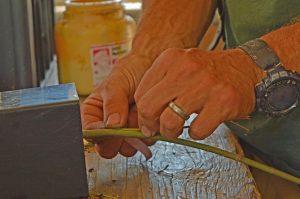 Summer heat is upon us and while many gardeners in Western Washington are simply trying to keep things alive during these hot dry months, we are in the heart of our propagation season. Mid July is when the new wood of the Japanese maples begins to harden off, and that’s when the grafting begins. We graft about 300 Japanese maples each year to replenish our stock, and the tiny plants that are propagated today may not reach the sales yard for five years or more…a testament to the time it takes to grow a beautiful, mature specimen.
Summer heat is upon us and while many gardeners in Western Washington are simply trying to keep things alive during these hot dry months, we are in the heart of our propagation season. Mid July is when the new wood of the Japanese maples begins to harden off, and that’s when the grafting begins. We graft about 300 Japanese maples each year to replenish our stock, and the tiny plants that are propagated today may not reach the sales yard for five years or more…a testament to the time it takes to grow a beautiful, mature specimen.
But why go through the trouble of grafting at all? Why don’t we just germinate a seed, or take a cutting?
While seedlings may indeed produce beautiful trees, they won’t produce exact replicas of the variety that we are trying to propagate because the sexual reproduction that leads to seed formation mixes up the genes. The seedling may be “better” or may be “worse,” but it is genetically distinct and therefore no longer the same as its mother tree.
And while cuttings, a form of asexual reproduction, would produce the clone we are trying to recreate, maples are known to be very difficult to root. Therefore the easiest, most convenient way to propagate maple varietals ends up being via graft. But “easy” and “convenient” are certainly not the first two words that come to mind when we discuss grafting of Japanese maples.
We use a side veneer graft, which in and of itself is not too complicated, but the wood of Japanese maples can prove difficult to work with. It is brittle, and often very small, and sometimes filled with many nodes that make for challenging knife work. If a good match can be made, and you can keep the young graft from desiccating during our 90 degree heat, then you have a pretty good chance of success.
Japanese maples are one of the most varied plant groups in our region, and each variety has its own distinct beauty. Some are known for striking fall color, some for their winter form. Others have incredible foliage owing to the shape or venation of the leaves. Most tolerate sun, and all will do well in the shade, and there are a wide array of sizes to fit into most any space in the garden.
We currently have 69 different varieties available, and each year we add a few more to our collection. We invite you to come see us and take a stroll through our gardens and the stock plants in our greenhouses to see which one catches your eye.
Shop available Japanese maples at Cloud Mountain Farm Center Nursery.

